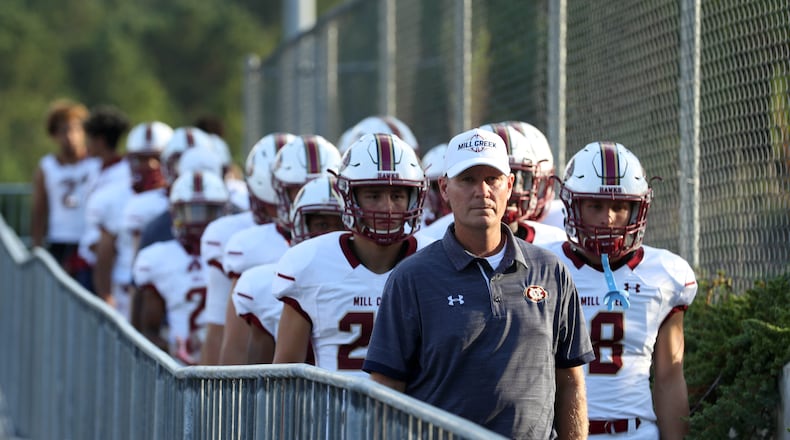Coaching a high school football program in a big city versus a small town has its stark differences. Shannon Jarvis, now at Elbert County, said there were more non-football-related activities that took up his time when he was at Mill Creek. Gilmer’s Paul Standard said he now works closely with his district’s board of education, but he couldn’t name a school board member when he coached in Gwinnett County. Monroe Area’s Kevin Reach said there are generations of fans with no current ties to the program who still show up every Friday night. That type of support was rare at Collins Hill.
In their own words, here are what the coaches had to say about moving from big-time, big-city programs to rural ones.
Shannon Jarvis, Elbert County (coached Mill Creek from 2004-18)
“The general public has no idea the demands of the head coach at larger schools, and not just in greater Atlanta, but South Georgia, too. A lot of the demands are not football-related. It takes so much time from your day and your true joy, which is coaching. I wouldn’t replace my time at Mill Creek for anything — not one bad feeling about my time there. I’m still best friends with (current Mill Creek coach Josh) Lovelady. We vacation together, and he has a lot on his plate. One thing I’ve thoroughly enjoyed this year is going into the rural community and getting the support of people who have been here generations. We played at Jefferson County (a 21-3 victory Sept. 23), and we’re in the locker room watching our fans come by. I saw at least 20 men and women come by that I know didn’t have a kid in the program — just in their 70s, driving down to see us. You don’t understand that type of community support unless you’re a part of it. I grew up in Elberton, and I’m glad I coached at a big school, but coming home means so much to me and the community. We have fans who have been season-ticket holders for 60 years, and they’re there every Friday night. For me, I put pressure on myself because I want the kids to play for those fans, and what they’re sacrificing. In metro Atlanta, when their kids graduate, the parents are gone.”
Paul Standard, Gilmer (coached St. Pius from 2001-20)
“I’m also the county athletic director, so for me, personally, there might not be that much difference. I will tell you the pace of life is tremendously slower here in the beautiful North Georgia mountains than metro Atlanta. That’s something my wife and I have certainly enjoyed since moving to Ellijay. I love Atlanta, and I wouldn’t trade it for anything. But we’re finally empty-nesters now, so we have enjoyed the slower pace of life. I will say this: I had a lot more coaches when I was at St. Pius and when I was an assistant at Dacula. Our football staff here is smaller, so we don’t work any less than we did in the big schools. Our time that we put in is the same, and in some cases, more. I never really worked that close with a board of education like I do now. In the smaller school systems, you work directly with with the board. In Gwinnett, I didn’t even know who was on the board, and it probably didn’t matter. At St. Pius, the hierarchy downtown didn’t affect us on the day-to-day. Here, that’s not the case. It’s been different here, in terms of going to the board to ask for supplementary raises for our high school and middle-school coaches as county AD. It was a long approval process, whereas in metro Atlanta, it was the principal who would help with that. There’s been a learning curve for me, but the board here has been great to work with and tremendously supportive of our athletics in Gilmer County.”
Kevin Reach, Monroe Area (coached Collins Hill from 2010-16)
“At Collins Hill there always seemed to be something going on — speaking engagements, booster-club meetings, radio shows, etc. It was demanding on your family, at times. Here, I don’t get bombarded with that. You still have your speaking engagements and things like that, but nothing like what it was. Back in the day at Collins Hill, we had three programs (ninth grade, JV and varsity) and 180 players. So the facilities had to be bigger and better. Just trying to keep up with three teams is a lot. It’s a different atmosphere. At Monroe Area, we just have JV and varsity. It’s not the same amount of helmets, shoulder pads, different things like that ... the differences in scheduling buses and pregame meals, to all the nit-picky things people don’t see. I enjoyed being on the big stage. But it’s different for me with Monroe Area because it has that small-town feel, and they’ve been playing football since 1921. You see older people who have been part of Monroe Area and the football program, and they have a stake in rooting for their hometown team. At Collins Hill, you didn’t get that. Don’t get me wrong -- at Collins Hill they had a great student body, and they packed the place out. But at our games now, you’ll see someone who doesn’t have a kid in the program, but might have graduated from Monroe Area, which I think is cool.”
About the Author
The Latest
Featured


